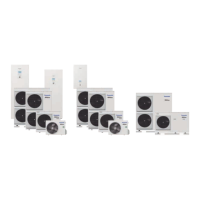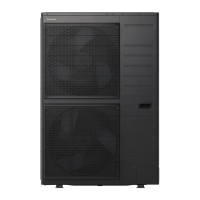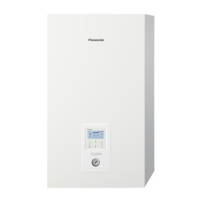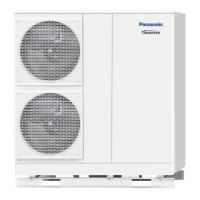
Do you have a question about the Panasonic Aquarea WH-ADC0309J3E5 and is the answer not in the manual?
| Model | WH-ADC0309J3E5 |
|---|---|
| Category | Heat Pump |
| Type | Air to Water |
| Power Input (Heating) | 2.5 kW |
| Energy Efficiency Ratio (Heating) | 3.6 |
| Refrigerant | R32 |
| Heating Capacity | 9.0 kW |
| Cooling Capacity | 8 kW |
| Energy Efficiency Ratio (Cooling) | 3.64 |
| Operating Temperature Range (Heating) | -20 ~ +35 °C |
| Power Supply | 230 V |
| EER | 3.64 |
Explains the manual's structure and content.
Lists the Aquarea heat pump systems covered in the manual.
Defines the proper and improper uses of the heat pumps.
Covers warnings about electric shock, frostbite, fire, and toxic gases.
Addresses damage from incorrect refrigerants, vibrations, water leaks, or fire.
Explains the functioning principle of an air-to-water heat pump with a diagram.
Defines COP, SCOP, and energy efficiency labels (ηs).
Explains the EU Ecodesign Directive framework for product design and energy efficiency.
Discusses ambient air as the primary heat source and considerations for planning.
Introduces the heat pump as the core system.
Covers how the heat pump is used for heating and domestic hot water.
Describes the cooling mode and its application with different transfer systems.
Differentiates between bi-bloc and mono-bloc system types.
Compares Aquarea series based on key characteristics and applications.
Explains the structure and meaning of the model codes for different system types.
Details the features of the Aquarea heat pumps.
Explains the configuration of bi-bloc systems, including indoor and outdoor units.
Details the components of the All in One unit (J generation, standard configuration) with diagrams.
Provides dimensions for Hydrokit models.
Provides detailed technical specifications for Bi-bloc systems with All in One units.
Explains the characteristics of mono-bloc systems.
Provides dimensions for mono-bloc units.
Provides detailed technical specifications for mono-bloc systems.
Covers the control system and remote controller functions.
Explains the operation and features of the remote controller.
Discusses connecting external accessories like thermostats or BMS.
Lists available accessories for Aquarea systems.
Introduces domestic hot water tanks and their features.
Introduces buffer tanks and their benefits.
Introduces combo tanks and their applications.
Introduces residential ventilation units with heat recovery.
Lists recommended on-site accessories and their specifications.
Covers principles of refrigeration technology and performance metrics.
Explains how to determine design outside temperature and heat load for buildings.
Guides on estimating domestic hot water demand and recommended tank sizes.
Explains heat pump operating modes and how to determine the bivalence point.
Provides an example calculation for determining total heating capacity.
Describes how to activate and control the cooling function.
Covers general criteria for installation.
Addresses noise levels and measurement of sound pressure.
Covers installation guidelines for bi-bloc systems, including pipe length and elevation differences.
Details installation requirements for outdoor units, including placement, distances, and noise.
Explains how to secure the outdoor unit with foundations or floor plates.
Outlines room requirements for indoor units, including volume calculations based on refrigerant charge.
Shows minimum clearance distances for indoor units.
Details installation guidelines for mono-bloc systems, including pipe insulation and frost protection.
Shows minimum clearance distances for mono-bloc units.
Explains how to secure mono-bloc units with foundations or floor plates.
Discusses hydraulic integration, pump usage, and separation of circuits.
Explains the process and importance of hydraulic balancing for system efficiency and comfort.
Covers electrical connection requirements and safety precautions.
Provides capacity tables based on operating conditions.
Illustrates various application examples for Aquarea heat pumps.
Provides a key to the hydraulic symbols used in the application examples.
Provides a key to the electrical components and terminals.
Highlights critical safety notes to observe before and during installation.
Guides on preparing for installation by checking requirements.
Explains the process of creating wall holes for cables, including safety warnings.
Covers the process of setting up indoor units.
Details installation steps for All in One units and Hydrokits.
Details steps for installing outdoor and mono-bloc units.
Covers procedures for opening devices for access.
Explains how to remove and replace the front plate of All in One units, with safety precautions.
Details removing and replacing the front plate and opening the connection box for Hydrokits.
Explains how to remove and replace the front plate of outdoor and mono-bloc units.
Covers connecting the refrigerant circuit, with a note for mono-bloc units.
Provides step-by-step instructions for connecting refrigerant pipes to indoor units.
Explains how to connect refrigerant pipes to the outdoor unit, with safety warnings.
Covers connecting the heating circuit, with cautions for bacteria, freezing, and corrosion.
Provides steps for connecting water pipes to indoor or mono-bloc units, including torque specifications.
Details connecting condensation and water drain pipes, with safety notes.
Covers connecting electrical wiring, including safety warnings and requirements for cable connections.
Details how to connect the power cord.
Explains how to connect the cable between indoor and outdoor units for bi-bloc systems.
Explains how to connect the power cord to mono-bloc units.
Covers connecting optional accessories.
Details connecting accessories to indoor units, including cable routing and fixing.
Details connecting accessories to mono-bloc units, including cable routing and fixing.
Provides a brief overview of external interfaces on the Main PCB and optional PCB.
Explains the installation and connection of the remote controller, with safety warnings.
Covers the process of starting up the system, including evacuation, filling, and testing.
Explains how to evacuate the refrigerant circuit and perform a pressure test.
Covers filling and venting the water system.
Details steps for filling and venting the heating or cooling circuit.
Outlines checks to perform on the installed system before test run.
Explains the procedure for performing a test run of the system.
Covers system handover, commissioning report, and customer instruction.
Details how to check and maintain the system's water pressure.
Explains how to check the pressure relief valve's functionality.
Explains how to check the functionality of the RCCB.
Guides on checking the air purge valve and venting the system.
Outlines procedures and safety precautions for maintenance on the refrigerant circuit.
Provides an extract of operating instructions for J Generation bi-bloc systems as an example.
Details the buttons and display elements of the remote controller.
Guides on initial setup of the remote controller, including language and clock settings.
Introduces the menu structure for user and installer settings.
Details installer setup menus for Optional PCB connectivity, Zone & Sensor, Heater capacity, Anti freezing, and DHW capacity.
Lists common symptoms and their potential causes, and checks before calling for service.
Lists error codes and their explanations.











